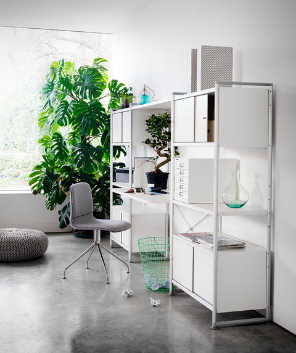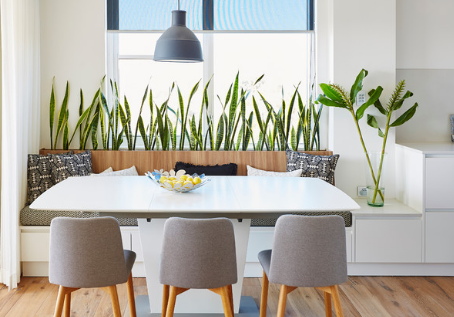

If you’re new to gardening or have had bad luck keeping houseplants alive in the past, bookmark this list. These 10 foolproof plants with their forgiving growth Xi and stylish forms and leaves will boost your indoor gardening confidence. We have the usual easy-to-care suspects – look at you, air plants and succulents – as well as varieties you may have seen in the nursery but never grown before.
Before buying a new houseplant, assess the light and temperature of your indoor space. Look for places with direct sunlight, bright indirect sunlight (the favorite way many houseplants are exposed), and places with little sunlight. Learn what size plant (small, medium, or large) and form (upright, loose filler, or trailer) works best for each space. Find your heating equipment and plan to keep the plants away from these areas.

The staghorn fern, also known as the staghorn fern, is regarded as the antlers of the plant kingdom. These epiphytes, also known as air plants, do not need soil to grow and can thrive on wooden blocks with water moss. They’re perfect for filling empty spaces on walls or bookshelves, where they can receive bright, filtered light. Plant one fern or three ferns side by side for more impact.
Care tip: Mounts the fern on a wooden block on the wall and uses bright indirect light. Soak it (the block and all the parts) in water for a few minutes a week and spray it every few days.

Also known as the Swiss cheese plant, this decorative liana has leaves the size of a dinner plate and are shiny, with cracks and holes in the leaves. Take advantage of this large-scale aesthetic to add a tropical drama to any room with medium to bright light. Philodendron grows luxuriantly in humid environments, such as damp bathrooms.

Care tip: Grow in medium to bright light, watering weekly to keep the soil moist and provide it with plenty of room to stretch.
Caution: If ingested by pets or young children, philodymic taro is poisonous.

A favourite in Victorian greenhouses and conservatories, these elegant palm trees boast delicate arched leaves and erect growing Xi. Choose a place that is tall enough – Kentia palms can reach up to 10 feet tall – where the plants are not crowded with furniture or other plants to accentuate the elegant form.
Care tip: Grow weekly or slightly less frequently, in bright to moderate light and under water. To prevent palm root rot, plant it in a well-drained soil mixture, such as the one for palm and succulents for sale, and let the top 3 inches of soil dry out between waterings.

Pothos is an easy-going and versatile houseplant. Pothos has smooth oval leaves and a fast-growing Xi, and even if you ignore it, it will exude health and vitality. Plant potted pothos, walk down the bookshelves, stroll around the table, or climb up the bathroom window as a jungle screen.
Care tip: Plant it weekly in a place with bright to moderate indirect sunlight and water. The plant can also tolerate a small amount of water for two weeks.
Caution: Pothos may be poisoned if ingested by pets and children.

A few years ago, we almost never saw these funky epiphytes outside of orchid exhibitions, but now they seem to be the darlings of every decorator. Follow the trend and put some soilless plants in a shallow bowl for tabletop displays, tuck them into glass balls hanging from windows, or arrange some wall-mounted grow corner vignettes.
Care tip: It’s easy to forget to take care of air plants, but if their tips turn brown, they’re thirsty. Submerge them in water for a few minutes a week and spray them every few days to keep them happy and encourage them to flourish. Air plants grow best in bright indirect light.

If you’ve ever seen lush plants in overlooked places like flower pots or office parks in malls or airports, it’s likely that they’re your mother-in-law’s tongue. Almost all species of saxifera (also known as snake plants) are the most bulletproof of plants. If you have a dark corner where nothing else can grow, or have a record of forgetting to water for a few weeks, then go for Saxifrage – it won’t disappoint you.
Care tip: Plant in an area with indirect to moderate light (can also tolerate low light). Allow the top 3 inches of soil to dry out between waterings, especially in winter.
Caution: Saxifrage leaves can be toxic to pets and children if ingested.

These succulent, sometimes prickly plants are very easy to grow and come in a variety of sizes and shapes. Agave orchid, aloe vera, stone lotus, sedum, white palm, longevity flower, and jade plants are all common plants that grow well indoors in sunny places. Put cacti and succulents together and display them on the windowsill.
Care tip: Most cacti grow in full sunlight and most succulents grow in bright, indirect light. Use a quick-draining potting mix and allow the soil to partially dry between waterings. Do not overwater.
For the tops of shelves and cabinets, look for succulents such as pearl strings (Senecio rowleyanus) (pictured), or creeping mistletoe cacti (Rhipsalis spp) hanging from the edges.

Dracaena is a tough, pliable plant with palm-like leaves that range in color from silvery variegated to dark green with red stripes. Dracaena (D. marginata) and the smaller dracaena (D. deremensis) are most commonly planted as houseplants. Popular in the 60s and 1970s of the 20th century, Dracaena has a retro vibe that complements the modern décor of the Middle Ages.
Care tip: Grow in moderate indirect light, water weekly during the growing season and allow the soil to dry in between winter waterings.
Caution: Dracaena can be toxic to pets and children if ingested.

Rubber plants belong to the fig family and make excellent indoor shrubs and trees, reaching heights of 6 to 8 feet. Use large specimens to secure a corner of the living room to provide a dark, rich backdrop. Smaller potted rubber plants make great tabletop decorations to admire up close with their deep purplish-red leaves.
Care tip: Grow in bright, indirect light, water weekly during the growing season and allow the soil to dry in between winter waterings.
Note: Rubber plants can be toxic to pets and children if ingested.

With an abundance of shiny dark leaves and white flowers that stand upright like candles, the peace lily keeps giving without asking for anything in return. If any of the leaves turn yellow (indicating overwatering or underwatering), gently pull them out from the base and the plant will quickly grow new growths.
Care tip: Grow in moderate, filtered light (can also tolerate low light); Keep out of direct sunlight. Water weekly to keep the soil moist, but don’t leave it in the water.